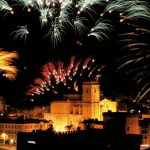Last updated on February 19th, 2020 at 01:25 am.
If you want to go hiking in Spain then you really are spoilt for choice. Spain has 14 national parks, every one of which can be an interesting alternative for a hike. We mention some of these routes in this article, but it is impossible to cover all of them.
It’s worth noting that although most people associate Spain with hot weather, many of these hikes will require you to have the usual clothing for inclement weather too. You need waterproof hiking boots, a raincoat and something warm to wear. Some of the hikes include more mountainous areas where you will find snowy peaks. Be prepared.
Of course, you must also prepare for clear days of sunshine. Take your suntan lotion too, and make sure that you use it. People are often caught out when it’s chilly but the sunshine means that you can still get burnt. Make sure you have plenty of water with you and avoid walking in the early afternoon when the weather is at its hottest.
If you would like your hike to include some cultural experiences then you might also take a look at Spain’s World Heritage Cities. Some routes combine walks with visits to interesting buildings and historical sites. Many of the treks have lodges and rural houses where you can book a night’s stay, if you’re not the camping kind.
Camino de Santiago
Most people have heard of the Camino de Santiago which is without a doubt the most famous walking route. Caroline Clinton from Ábaco’s Customer Care Department, has walked this route and you can read about her experiences here: http://www.abacoadvisers.com/spain-explained/life-in-spain/news/camino-de-santiago You don’t have to walk it in its entirety. There are plenty of sections that you can choose from which are less of a pilgrimage but give you a flavour of what the route has to offer.
Caminito del Rey
This hike along the El Chorro Canyon was known as being one of the most dangerous hikes in the world as sections of it were previously incomplete and relied on the skills of the walker and sometimes on climbing skill too. This infamous route has recently been restructured to make it slightly safer than it was previously. However, it is still a pretty tricky trek and one that should meet the needs of adrenaline junkies.
This hiker describe the experience before the route was renovated:
https://expertvagabond.com/caminito-del-rey/
Now it is a much safer option:
http://www.independent.co.uk/travel/europe/caminito-del-rey-malaga-kings-pathway-walkway-of-death-most-dangerous-trail-path-a7713741.html
The Mulhacén, Sierra Nevada
If you like heights but aren’t wanting to conquer the Caminito del Rey, you might like to try climbing the Mulhacén which is the highest mountain on the Iberian Peninsula. There is the advantage here that there are several trails you can choose from according to your level of mountaineering skill. The easiest is that of the southern face which takes around two hours.
Which of these routes you prefer is very much a matter of personal preference. Suffice to say that you are spoilt for choice by the variety of Spain’s rugged and gentle scenery.
The Picos de Europa
These are a range of mountains in northern Spain and were supposedly the first land seen by sailors who were returning from the Americas. They are rich with fauna and flora and you can also indulge in pot-holing and rock-climbing if you want to do something a little more energetic.
In the article below the variety is described from valley strolls to high mountain circuits – it is claimed that there is something for everyone. The most famous route it suggests is the Cares Gorge Walk with a path carved into the cliff faces and a number of bridges and tunnels.
There are some pretty big examples of wildlife too that you might encounter. Wolves and Cantabrian brown boars are just some of the species you might see. The western, eastern and central massifs all have a number of mountain refuges, where you can have something to eat and sleep.
https://www.asturiaspicosdeeuropa.com/tourism/picos-de-europa/walking-picos-de-europa
The Silver Way
This historic road connects Astorga to Mérida and is a favourite for those who wish to discover more about Spanish culture. The route itself dates back to the Roman Empire and was an important communication network. There are a number of historic buildings that you can view along the way. For example, Cáceres old town and a number of stately homes and palaces. It has been a World Heritage Site since 1986.
If you pick your time of year you can also take part in some traditional and interesting fiestas, including Iberian Ham Day which is held in Monesterio in Extremadura.
http://turismoextremadura.com/viajar/turismo/en/ven-a-extremadura/The-Silver-Way/
Ordesa y Monte Perdido, Aragon
Along with the Picos de Europa, this is one of Spain’s oldest national parks established in 1918. If you choose your hike here you will see amazing mountainous landscape with the mountain of Monte Perdido looking large. It’s also a World Heritage Site. It is more of a hike for mountaineers rather than those wanting a gentle stroll. You can book into a guided hike with the mountain guide service but this will cost you.
http://hitchhikershandbook.com/2012/07/28/ordesa-valley-valle-de-ordesa-aragon-spain/
La Rioja
Another alternative is to take a route surrounded by vineyards. La Rioja region is famous for its vineyards and wine production. You don’t have to be a wine connoisseur to enjoy trekking around this beautiful part of the country and visiting some of its vineyards. You can plan your treks around visits to the bodegas. Walking World recommend that you stop off at the Bodega and Museum Dinastia Vivanco at Briones.
http://www.walkingworld.com/Walks/Spain/North%20East%20Spain/Rioja.aspx
Valverde de los Arroyos
One interesting trek is up the mountain el Pico del Ocejón. It’s 2,049 metres in height and if you get to the top then you have views of much of the province of Guadalajara.
You begin your journey from the town of Valverde de los Arroyos. If you keep to the left on the way up you should be able to see the waterfall Despeñalagua. You can’t get too close to the waterfall but it is still worth including in your route and you can get closer on your descent.
You can expect to see snow at the top of the route in the winter and a lot of greenery in the summer. Before the final climb there is a large meadow area where you still have glorious views but it is not quite so steep as on the last part of your trek.
As you come close to the top, expect the mountain to be capped with snow. For this reason and because the final climb is slightly more vertical you should have crampons with you and an ice pick.
The reward for climbing to the top is the amazing view. You will feel as though you are on the top of the world.
The Camino de Vera Cruz
This walk extends from the north of Spain to the south, ending at Caravaca de la Cruz which is a town on the border of Murcia and Granada. It is particularly popular for its rural tourism and is classed as one of 5 Holy Cities in the world. In fact, Spain has three of the world’s five holy cities: Santiago de Compostella, the Monastery of Santo Toribio and Caravaca de la Cruz. The other two are Rome and Jerusalem.
There are a number of different routes that you can take and it is less well known than that of the Camino de Santiago and as such there are fewer catering establishments for tourists. Murcia Today describes a free tour that you can take if you would like to see some of the key buildings with a guide. This tour is in Spanish:
http://www.murciatoday.com/microsite/walking/Caravaca-de-la-cruz.html
And more…
We have barely tickled the surface of the endless possibilities there are for hiking in Spain. You have the luxury of so many different routes across such a variety of terrain that there should be no problem in finding one to suite you.
Top 10 national parks in Spain:
https://www.theguardian.com/travel/2016/mar/01/top-10-national-parks-spain-andalucia-tenerife-balearics
Spain’s lesser known UNESCO world heritage sites:
http://www.nationalgeographic.com/travel/destinations/europe/spain/spain-lesser-known-unesco-world-heritage-sites/
Top 10 UNESCO World Heritage Sites, Spain:
http://www.autoeurope.com/blog/all-about/top-10-unesco-world-heritage-sites-spain
El País has a lovely collection of photos of what it considers to be the top hiking trails:
https://elpais.com/elpais/2016/04/01/album/1459509904_637712.html
Lonely Planet has its own section on the Best hiking in Spain:
https://www.lonelyplanet.com/spain/collections/hiking/a/col/28f98e15-978b-4e93-83c5-b91dcf752c5b/360727
2 comments
13 March, 2023 12:51 pm
Is it legal to hike or camp off the trail in Spanish National Parks?
16 March, 2023 3:19 pm
It is not legal to camp in most Spanish National Parks, but some exceptions may occur, but would have to be revised with each National Park.
With kind regards,
Ábaco Advisers






Leave a comment